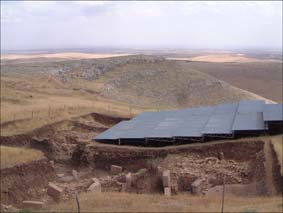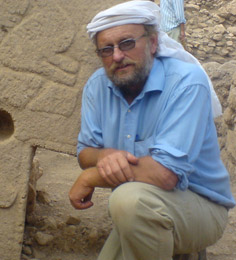| |
|
![]()
Thursday, 19 October 2006
GOBEKLI TEPE -EDEN FOUND?
Archaeologist now claims that Gobekli Tepe is evidence not only for the oldest temple in the world, but also the Garden of Eden

Gobekli Tepe looking south (pic credit: Andrew Collins)
Incredible new developments are afoot surrounding the discovery of Gobekli Tepe, billed as the Oldest Temple in the World. The last year of excavations at the 11,500-year-old proto-Neolithic site close to Sanliurfa (ancient Eddessa) and the ancient Sabian city of Harran, has uncovered a large number of beautiful carved statues, including headless humans, lizards, wild birds, serpents and, I'm always happy to reveal, vultures. In addition to this, 20 new cult rooms have been unearthed locally.
|
Klaus Schmidt of the German Archaeological Institute (pic credit: Sean Thomas |
The headless human figures are a puzzle for the archaelogist Dr Klaus Schmidt of the German Archaeological Institute. However, as I revealed in FROM THE ASHES OF ANGELS, GODS OF EDEN and in the new book, they surely represent denuded bodies undergoing the process of excarnation. Their heads are missing because these were the symbol of the soul, shown in Neolithic murals found at the Neolithic city of Catal Huyuk in Southern Turkey and dating to 6500 BC as being escorted into the afterlife by vultures, the ultimate bird associated with the Neolithic cult of the dead in the Near East. They were seen as psychopomps, soul-carriers, the role played by swan and goose (and sometimes the crow or raven) in Europe. |
What is even more significant about the new discoveries from Gobekli Tepe is that Klaus Schmidt, a very forward thinking archaeologist, is now beginning to realise that this must have been the place of emergence of the Neolithic in the ancient world towards the end of the last ice age, c. 11,500 years ago. The fact that so many firsts in human kind's evolution occurred in this one small region of the globe parallels not only the ideas expressed in the Book of Genesis concerning the Fall of Man, but also the fact that legend has long asserted that here was the biblical land of Eden. This is exactly what I said in FROM THE ASHES OF ANGELS back in 1996, repeated also in GODS OF EDEN in 1998, but then Gobekli Tepe had only just been discovered and was not even known to me.
Recently, Egyptologist, writer and broadcaster David Rohl also apparently come to believe that Gobekli Tepe marks the point of genesis of civilization, and is thus the best candidate by far for the site of the Garden of Eden. This follows on from his claims in his book LEGEND: THE GENESIS OF CIVILIZATION, the Eden material being inspired by FROM THE ASHES OF ANGELS (he told me so), which saw the land of Eden as a much larger region embracing SE Turkey, Western Iran and Northern Iraq (indeed, he placed his 'Garden' east of Lake Urmia in Western Iran). We had friendly arguments over this, whereby I stated that textual and oral evidnence indicated that Eden was located between the inland sea of Lake Van and the coast of the Mediterranean in Northern Syria, and thus was essentially in SE Turkey (Turkish Kurdistan). He insisted it wasn't, but has now, seemingly, changed his tune. Wait till I speak to him!
All this is good news for me, for it vindicates my work, which makes me very happy indeed.
Anyway, you can read all about Gobekli Tepe and other local proto-Neolithc sites in THE CYGNUS MYSTERY, copies of the special limited edition are available now by clicking here.
![]()
|
|
